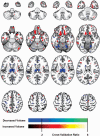Heterogeneity and Classification of Recent Onset Psychosis and Depression: A Multimodal Machine Learning Approach
- PMID: 33543752
- PMCID: PMC8266654
- DOI: 10.1093/schbul/sbaa185
Heterogeneity and Classification of Recent Onset Psychosis and Depression: A Multimodal Machine Learning Approach
Abstract
Diagnostic heterogeneity within and across psychotic and affective disorders challenges accurate treatment selection, particularly in the early stages. Delineation of shared and distinct illness features at the phenotypic and brain levels may inform the development of more precise differential diagnostic tools. We aimed to identify prototypes of depression and psychosis to investigate their heterogeneity, with common, comorbid transdiagnostic symptoms. Analyzing clinical/neurocognitive and grey matter volume (GMV) data from the PRONIA database, we generated prototypic models of recent-onset depression (ROD) vs. recent-onset psychosis (ROP) by training support-vector machines to separate patients with ROD from patients with ROP, who were selected for absent comorbid features (pure groups). Then, models were applied to patients with comorbidity, ie, ROP with depressive symptoms (ROP+D) and ROD participants with sub-threshold psychosis-like features (ROD+P), to measure their positions within the affective-psychotic continuum. All models were independently validated in a replication sample. Comorbid patients were positioned between pure groups, with ROP+D patients being more frequently classified as ROD compared to pure ROP patients (clinical/neurocognitive model: χ2 = 14.874; P < .001; GMV model: χ2 = 4.933; P = .026). ROD+P patient classification did not differ from ROD (clinical/neurocognitive model: χ2 = 1.956; P = 0.162; GMV model: χ2 = 0.005; P = .943). Clinical/neurocognitive and neuroanatomical models demonstrated separability of prototypic depression from psychosis. The shift of comorbid patients toward the depression prototype, observed at the clinical and biological levels, suggests that psychosis with affective comorbidity aligns more strongly to depressive rather than psychotic disease processes. Future studies should assess how these quantitative measures of comorbidity predict outcomes and individual responses to stratified therapeutic interventions.
Keywords: MRI; comorbidity; depression; gray matter volume; machine learning; psychosis; transdiagnostic.
© The Author(s) 2021. Published by Oxford University Press on behalf of the Maryland Psychiatric Research Center.All rights reserved. For permissions, please email: journals.permissions@oup.com.
Figures



References
-
- Bzdok D, Meyer-Lindenberg A. Machine Learning for Precision Psychiatry: Opportunities and Challenges. Biol Psychiatry Cogn Neurosci Neuroimaging. 2018;3(3):223–230. - PubMed
-
- Wong EH, Yocca F, Smith MA, Lee CM. Challenges and opportunities for drug discovery in psychiatric disorders: the drug hunters’ perspective. Int J Neuropsychopharmacol. 2010;13(9):1269–1284. - PubMed
Publication types
MeSH terms
LinkOut - more resources
Full Text Sources
Other Literature Sources
Medical

